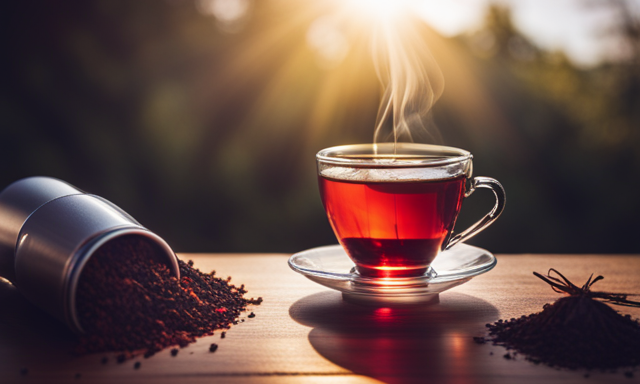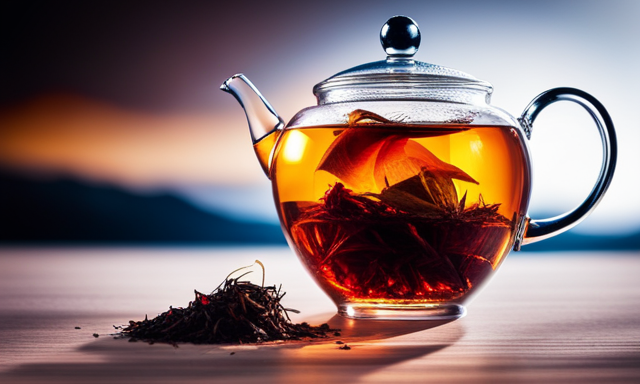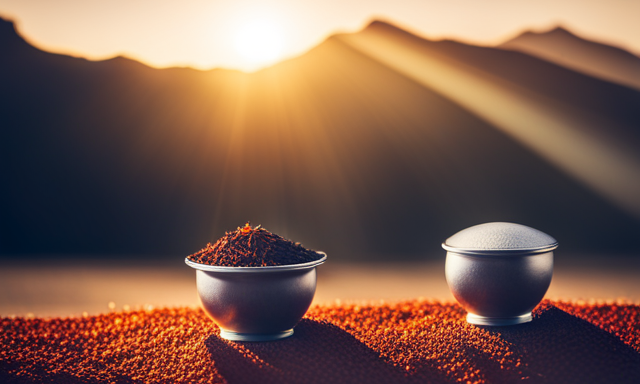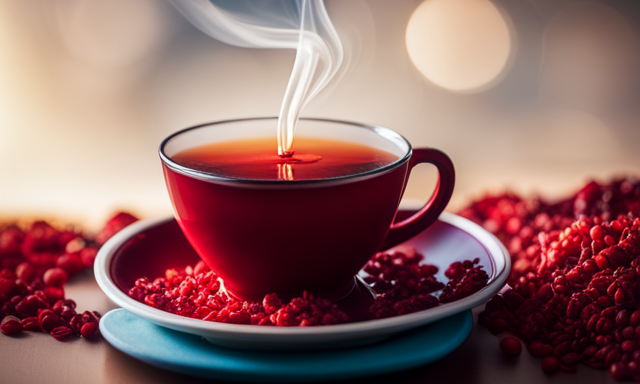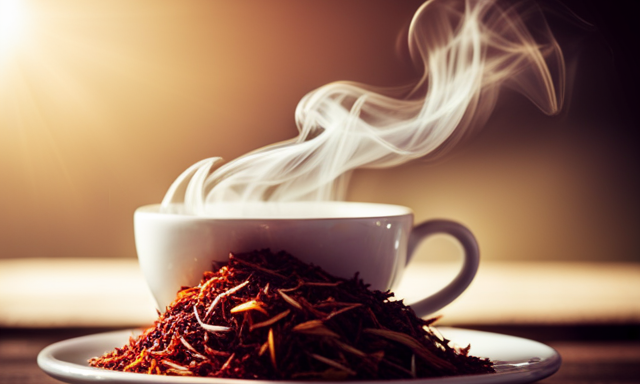As a tea lover, I have always been fascinated by the vast variety of flavors and aromas that different types of tea offer.
One of the most intriguing comparisons I have come across is the difference between chai and rooibos tea. These two beverages may seem similar at first glance, but their distinct characteristics set them apart in the world of tea.
Chai tea, with its rich blend of spices like cinnamon, cardamom, and ginger, provides a warm and comforting experience for the palate.
On the other hand, rooibos tea, derived from the leaves of the South African red bush plant, offers a naturally sweet and nutty flavor with hints of caramel.
In this article, we will delve into the unique flavor profiles, brewing methods, caffeine content, health benefits, and culinary uses of both chai and rooibos tea.
So grab a cup of your favorite tea and join me on this delightful exploration of the differences between chai and rooibos.
Key Takeaways
- Chai tea contains enzymes that improve digestion and reduce bloating, while rooibos tea has potent antioxidants that protect the body against free radicals.
- Chai tea contains spices like ginger, cardamom, and cinnamon, which have specific digestive properties, while rooibos tea is naturally caffeine-free and can help reduce caffeine intake.
- Chai tea is often enjoyed with milk and sweeteners, while rooibos tea can be enjoyed plain or with honey.
- Chai tea evokes a cozy and comforting feeling, while rooibos tea is calming and soothing.
Brief Introduction to Chai Tea
If you’re looking to add some spice and warmth to your tea experience, chai tea is the perfect choice for you! Chai tea is a flavorful blend of black tea, spices, and milk. It originated in India and has gained popularity worldwide for its unique taste and numerous health benefits.
Chai tea is known for its ability to boost digestion, improve heart health, and provide relief from inflammation. Additionally, the spices in chai tea, such as cinnamon and ginger, offer antioxidant properties that can strengthen the immune system.
There are various chai tea recipes available, allowing you to customize your drink to your preferences.
Now, let’s move on to a brief introduction to rooibos tea, a caffeine-free alternative with its own distinct qualities.
Brief Introduction to Rooibos Tea
Let’s start by getting to know the wonderful world of Rooibos tea!
-
Rooibos tea, also known as red tea, is made from the leaves of the Aspalathus linearis plant, native to South Africa. It’s naturally caffeine-free, making it a great alternative to traditional teas.
-
Rooibos tea is known for its rich antioxidant content, including polyphenols and flavonoids. These antioxidants can help boost the immune system and promote overall health.
-
Brewing techniques for Rooibos tea involve steeping the leaves in hot water for 5-7 minutes to extract its full flavor.
-
As for its nutritional value, Rooibos tea is low in tannins and contains minerals like calcium, potassium, and magnesium.
Moving on to the flavor profile comparison, Rooibos tea offers a unique, sweet and nutty taste that sets it apart from other teas.
Flavor Profile Comparison
Rooibos tea offers a unique, sweet and nutty taste that sets it apart from other teas, but have you ever wondered how its flavor profile compares to that of traditional black tea? When it comes to flavor preferences, it ultimately depends on personal taste.
Rooibos tea is naturally caffeine-free and has a smooth, mellow flavor with subtle hints of vanilla and honey. On the other hand, black tea has a bolder, robust flavor with notes of malt and sometimes even a slight bitterness. While some may prefer the comforting and earthy taste of rooibos, others may gravitate towards the stronger and more pronounced flavor of black tea.
Now that we’ve explored the flavor differences, let’s delve into the brewing and preparation methods that bring out the best in each tea.
Brewing and Preparation Methods
When it comes to brewing chai tea, I prefer using the stovetop or simmering method. This involves heating a mixture of water, milk, spices, and tea leaves on the stovetop until it reaches a simmer, then allowing it to steep for a few minutes before straining.
On the other hand, rooibos tea is best prepared using the steeping method. Simply add boiling water to a cup or teapot containing rooibos tea leaves and let it steep for a few minutes before straining.
Chai Tea – Stovetop or Simmering Method
To achieve the aromatic and robust flavors of chai tea, it’s best to brew it using the stovetop or simmering method. This method involves combining water, tea leaves, spices, and milk in a pot and bringing it to a simmer. The simmering allows the flavors to meld together, creating a rich and satisfying beverage.
To give you a visual of the process, here’s a table outlining the steps:
| Stovetop Method |
|---|
| 1. Heat water in a pot. |
| 2. Add tea leaves and spices. |
| 3. Simmer for 10-15 minutes. |
| 4. Add milk and sweetener if desired. |
| 5. Strain and serve hot. |
Now, let’s move on to the next section about rooibos tea and its steeping method. It offers a different brewing experience, resulting in a unique flavor profile.
Rooibos Tea – Steeping Method
If you’re a fan of herbal infusions, you’ll be intrigued to learn that rooibos tea has gained popularity with a 74% increase in sales over the past year. This caffeine-free South African beverage is known for its vibrant red color and distinctive flavor.
To prepare rooibos tea, a steeping method is commonly used. The recommended steeping time for rooibos tea is around 5-7 minutes, allowing the flavors to fully develop. It’s important to control the temperature of the water when steeping rooibos tea, as boiling water can lead to a bitter taste. To achieve the best results, water should be heated to around 200°F (93°C). This ensures a smooth and flavorful cup of rooibos tea.
Transitioning into the next section about caffeine content, it’s interesting to note that rooibos tea is naturally caffeine-free.
Caffeine Content
In chai tea, you’ll experience a warm and comforting blend of spices, while in rooibos tea, you’ll savor a smooth and soothing caffeine-free drink. When comparing chai tea to black tea, the main difference lies in the caffeine content.
Chai tea is typically made with black tea as its base, which contains caffeine. However, the amount of caffeine can vary depending on the brand and preparation method. On the other hand, rooibos tea is naturally caffeine-free, making it a great alternative for those looking to reduce their caffeine intake. This can be particularly beneficial for individuals who are sensitive to caffeine or those who want to enjoy a warm beverage without it impacting their sleep quality.
Moving forward, let’s explore the traditional uses and cultural significance of both chai and rooibos tea.
Traditional Uses and Cultural Significance
Explore the rich history and cultural significance of both chai and rooibos tea, and discover how they have been used in traditional practices. Chai tea, a traditional Indian beverage, has been consumed for centuries and is deeply ingrained in Indian culture. It is often served during social gatherings and religious ceremonies, symbolizing hospitality and warmth. In contrast, rooibos tea, originating from South Africa, holds a special place in the traditional rituals of the indigenous Khoi and San peoples. They have long recognized its medicinal properties and used it in healing ceremonies. To convey a deeper understanding, here is a table showcasing the traditional uses and cultural significance of chai and rooibos tea:
| Chai Tea | Rooibos Tea | |
|---|---|---|
| Traditional Uses | Welcoming guests, religious ceremonies | Healing ceremonies, promoting overall well-being |
| Cultural Significance | Symbolizes hospitality and warmth | Sacred and deeply rooted in indigenous culture |
Moving forward to the discussion on health benefits and potential risks, it is important to understand the historical and cultural context of these teas.
Health Benefits and Potential Risks
When it comes to health benefits, chai tea has the potential to aid in digestion. Its blend of spices, such as ginger and cardamom, can help soothe the stomach and alleviate digestive discomfort.
On the other hand, rooibos tea is known for its antioxidant properties. These antioxidants can help protect cells from damage caused by harmful molecules called free radicals.
Chai Tea – Potential Digestive Benefits
Chai tea can help soothe your digestive system and make you feel more comfortable after a meal. It contains a blend of spices like ginger, cardamom, and cinnamon, which have been traditionally used as digestive aids. These spices can help stimulate the production of digestive enzymes, improve digestion, and reduce bloating and indigestion.
To give you a better understanding of the potential digestive benefits of chai tea, here is a table showcasing some of the key spices found in chai and their specific digestive properties:
| Spice | Digestive Property |
|---|---|
| Ginger | Reduces nausea and improves digestion |
| Cardamom | Relieves heartburn and indigestion |
| Cinnamon | Stimulates digestion and reduces bloating |
By incorporating these spices into your chai tea, you can support your digestive health and enjoy a warm and comforting beverage. Now, let’s move on to the next section where we’ll explore the antioxidant properties of rooibos tea.
Rooibos Tea – Antioxidant Properties
Moving on from the potential digestive benefits of Chai tea, let’s now delve into the antioxidant properties of Rooibos tea. As a tea lover, I’m fascinated to explore the various health benefits different teas offer.
Rooibos tea, also known as red bush tea, is renowned for its potent antioxidants that can help protect the body against free radicals. These harmful molecules can damage cells and contribute to aging and disease. The antioxidants in Rooibos tea, such as aspalathin and quercetin, have been shown to have anti-inflammatory and immune-boosting effects.
Additionally, Rooibos tea is naturally caffeine-free, making it a great choice for those looking to reduce their caffeine intake. However, like any beverage, it’s important to consume Rooibos tea in moderation and be aware of any potential health risks.
Now, let’s move on to explore the exciting world of pairing suggestions and culinary uses.
Pairing Suggestions and Culinary Uses
For a delightful culinary experience, explore the diverse pairing possibilities and culinary uses of both chai and rooibos tea.
Chai tea, with its rich and spicy flavor, pairs well with sweet and savory foods alike. It complements desserts like chocolate cake or cinnamon rolls, and also pairs beautifully with savory dishes like spicy curries or grilled meats. Chai can also be used as an ingredient in cooking, adding warmth and depth to dishes like chai-infused oatmeal or chai-spiced pancakes.
On the other hand, rooibos tea has a naturally sweet and nutty flavor that pairs well with fruits, nuts, and cheeses. It can be used as a base for refreshing iced teas, or incorporated into recipes like rooibos-infused sorbet or rooibos-glazed salmon.
With their versatile flavors, both chai and rooibos teas can elevate your culinary creations to new heights.
As we explore the availability and accessibility of these teas, it becomes clear that they are widely enjoyed and readily accessible.
Availability and Accessibility
Chai tea is widely available in various forms, making it easily accessible to tea enthusiasts like myself. Whether you prefer loose leaf, tea bags, or even pre-made concentrates, you can find chai tea in most grocery stores, specialty tea shops, and online retailers.
On the other hand, rooibos tea is gaining popularity globally, with its unique flavor and numerous health benefits attracting a growing number of tea drinkers. While it may not be as widely available as chai tea yet, rooibos tea can still be found in many health food stores and online platforms.
Chai Tea – Widely Available in Various Forms
First off, did you know that chai tea comes in many different forms and can be found in stores all over? Here are four popular forms of chai tea that you can easily find:
-
Chai Tea Bags: These are convenient and perfect for brewing a quick cup of chai tea at home or the office. Just steep the tea bag in hot water and enjoy the aromatic flavors.
-
Chai Concentrate: This is a syrup-like liquid that can be mixed with hot or cold milk for a creamy and indulgent chai tea experience. It’s great for making lattes or iced chai drinks.
-
Chai Powder: This is a powdered form of chai tea that can be used for baking or making chai-flavored desserts. It adds a unique twist to your favorite recipes.
-
Ready-to-Drink Chai: These are pre-packaged bottles or cans of chilled chai tea that you can grab on the go. They are convenient for those busy days when you need a quick energy boost.
Now, let’s dive into the next section about rooibos tea – gaining popularity globally.
Rooibos Tea – Gaining Popularity Globally
Rooibos tea, with its rich and earthy flavors, has been steadily gaining popularity across the globe like wildfire. This herbal tea, also known as red bush tea, originates from South Africa and has captivated tea lovers with its unique taste and numerous health benefits.
Its global popularity can be attributed to its caffeine-free nature, making it a suitable choice for those looking for a soothing and calming beverage. Additionally, Rooibos tea is rich in antioxidants, which help in boosting the immune system and promoting overall well-being. Its anti-inflammatory properties have also been linked to reducing the risk of heart disease and improving digestion.
As a tea enthusiast, I highly recommend trying Rooibos tea for its delightful taste and health benefits.
Transitioning to the next section, let’s explore personal preferences and recommendations.
Personal Preferences and Recommendations
When it comes to personal preferences and tea recommendations, the difference between chai and rooibos tea can be a matter of taste and mood. Here are some factors to consider:
-
Flavor: Chai tea, with its blend of spices like cinnamon, cardamom, and ginger, offers a warm and bold flavor. On the other hand, rooibos tea has a naturally sweet and nutty taste.
-
Caffeine content: Chai tea is typically made from black tea, which contains caffeine. Rooibos tea, however, is naturally caffeine-free, making it a great choice for those looking to reduce their caffeine intake.
-
Health benefits: Chai tea’s spices are known for their potential health benefits, such as reducing inflammation and boosting digestion. Rooibos tea, on the other hand, is rich in antioxidants and has been linked to improved heart health.
-
Versatility: Chai tea is often enjoyed with milk and sweeteners, making it a comforting and indulgent treat. Rooibos tea, on the other hand, can be enjoyed plain or with a touch of honey for a naturally sweet taste.
-
Mood: Chai tea’s warm and spicy flavors can evoke a cozy and comforting feeling, perfect for chilly evenings. On the other hand, rooibos tea’s sweet and nutty taste can be calming and soothing, making it a great choice for relaxation.
Ultimately, the choice between chai and rooibos tea depends on your personal preferences and the mood you’re in. Whether you crave bold flavors or prefer a naturally sweet taste, both teas offer unique qualities that can enhance your tea-drinking experience.
Frequently Asked Questions
How long should chai tea be steeped for optimal flavor?
For optimal flavor, chai tea should be steeped for around 4-5 minutes. Steeping it longer can enhance the flavor and aroma, allowing the spices to fully infuse into the tea. This results in a rich and robust taste.
Can rooibos tea be mixed with other herbs or spices to enhance its flavor?
Want to take your rooibos tea to the next level? Why not mix it with herbs or spices? Adding flavors like cinnamon or ginger can enhance the taste and offer additional health benefits.
Are there any potential risks or side effects associated with drinking chai or rooibos tea?
Drinking chai or rooibos tea is generally safe, but it’s important to be aware of potential risks. Excessive consumption of chai can lead to increased caffeine intake, while rooibos tea may interact with certain medications. Moderation and consulting with a healthcare professional is recommended.
What are some traditional uses of chai tea in different cultures around the world?
Chai tea is a traditional beverage enjoyed in various cultures worldwide. It is known for its rich flavors and health benefits. In India, chai is used in Ayurvedic medicine to aid digestion, while in Morocco, it is used to promote relaxation.
Are there any specific culinary uses or recipes that incorporate rooibos tea as an ingredient?
Rooibos tea is used in a variety of culinary creations. Its unique flavor adds depth to dishes like marinades, sauces, and desserts. Recipes include rooibos-infused ice cream, glazes for meat, and even rooibos tea cocktails.
Conclusion
In conclusion, after delving into the world of chai and rooibos tea, it’s clear that these two beverages offer distinct flavors, brewing methods, and health benefits.
While chai tea seduces the taste buds with its bold blend of spices, rooibos tea captivates with its smooth and nutty undertones.
The caffeine content in chai tea provides a much-needed energy boost, while the lack of caffeine in rooibos tea makes it a perfect choice for those seeking a relaxing and soothing beverage.
Both teas have their own unique culinary uses and can be enjoyed in various ways.
Ultimately, the choice between chai and rooibos tea boils down to personal preference, but one thing’s for sure – indulging in either of these teas is an experience that shouldn’t be missed.

